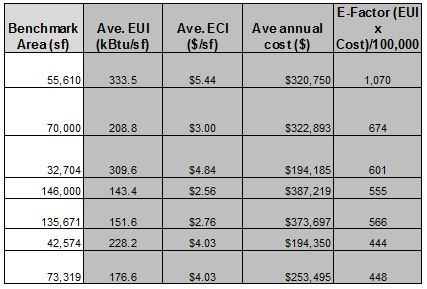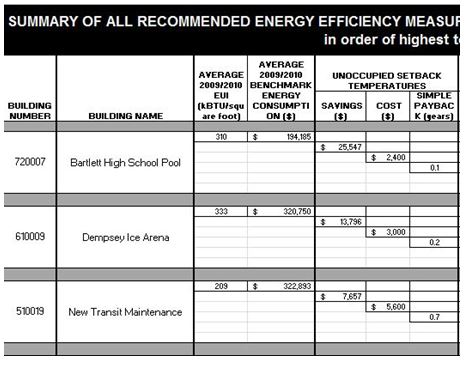|
June 2013
Article
AutomatedBuildings.com
|
[an error occurred while processing this directive]
(Click
Message to Learn More)
|
| Six Steps to Portfolio-wide Energy
Reduction
Technical insights, observations, lessons learned and just good solid
information about energy consumption and cost reduction in commercial,
industrial and municipal buildings.
|
 Jim Fowler, Jim Fowler,
PE, CBCP, CEA
Global Energy Audits
Published Blog
and
Noesis Energy
|
Six Steps to Portfolio-wide Energy Reduction
Do you have 5, 15 or 50 buildings? Amidst your day to day
responsibilities, it’s an overwhelming task to reduce energy
consumption across that many buildings. Whether you’re a
municipality, a property manager, a big box store owner or Kentucky
Fried Chicken, here are the 6 steps you need to take.
1. Benchmark your buildings and create a Portfolio Energy Summary: These days, Benchmarking is usually thought of in terms of EPA’s Portfolio Manager. This is recommended, but it’s not enough. Go ahead and create an account,
enter your building data and receive an Energy Star Score. You
can use this score to see how you compare to similar use
buildings.
Now here’s the important part. Create a Portfolio Energy
Summary. List your building inventory in a spreadsheet, include
square footage, the last two years of energy costs and the amount of
energy used, typically converted to BTU’s. Create two more
columns and divide the energy costs and energy use by the building
square footage – these columns are your energy cost index (ECI) and
your energy use index (EUI) for each building. Then calculate
what we call an “E-Factor” and put in a new column.
If you prioritize your buildings by the amount of energy spend you
don’t consider their efficiency or inefficiency. Alternatively,
if you prioritize by efficiency, you miss the cost factor – a terribly
inefficient building would not be near the top of your list if your
annual energy spend for that building is insignificant. So, we’ve
created what we call an “E-Factor”.
To calculate each building’s E-factor, multiply your average annual
cost by the building’s EUI and divide by 100,000 to get usable
numbers. Sort the E-Factor column from highest to lowest.
You now have an inventory list that considers the building’s efficiency
AND gives you an idea of the magnitude of savings possible.

There may be some
anomalies in the list, and each building should be considered more
deeply from maintenance, political and other viewpoints, but in
general, this is the master Portfolio Energy Summary you’re going to
working from to implement an energy reduction program.
2. Monitor your buildings: Energy Monitoring
serves the same purpose for your building operations as your Income
Statements and Balance sheet do for your business operations. “If
you don’t measure it, you can’t manage it.” There is a very wide
range of energy monitoring systems available, ranging from free to very
expensive. We typically recommend using the Noesis platform which
is free, and then automate the future addition of monthly consumption
and cost data by adding their Data Services at a cost of $10/meter for
set-up, plus $5/meter/month to download data directly from your utility
provider each month.
Whatever system you use, you will need trending, comparison and
reporting capabilities and it should be internet or intra-net based so
other stakeholders can also access this information.
Monitoring will give you an ongoing report of consumption, but as
importantly, you can use the annual figures to update your Portfolio
Energy Summary and re-prioritize your energy efficiency plan.
3. Audit worst performing buildings with the highest
potential savings:
In consultation with an energy auditor, choose 3-5
buildings and perform a comprehensive energy audit on each. The
auditor’s insight and experience should impact the buildings
chosen. For example, if there are four similar-use buildings with
similar HVAC systems, only one may need to be audited to learn about
all four. The auditor should create an “EEM matrix”
containing the
audited buildings and the recommended energy efficiency measures
(EEM’s). This EEM matrix should help determine which
recommendations should be implemented and in what order. For
example, if the shortest payback or highest ROI EEM’s consistently turn
out to be lighting upgrades, this suggests a lighting upgrade program
across all buildings should be implemented first and the savings used
to fund future EEM’s.
4. Using the EEM matrix, maintenance plans and
funding parameters, select which EEM’s to implement in what
order: The results of this step should be folded into
operating and capital plans and budgets. As part of an investment
grade audit, EEM costs are estimated by the auditor, as are payback and
ROI’s for each EEM. The costs should be updated annually by
contractors to assure accuracy for future budgeting.

5. Every 3-4 years, audit the next group of buildings
on the Portfolio Energy Summary: Using the annual data generated
from Monitoring and the continually updated Portfolio Energy Summary,
continue to work your way down the Summary list by auditing successive
groups of buildings.
[an error occurred while processing this directive]
6. Measurement and Verification (M&V): As much as
possible, the resulting savings from EEM’s that are implemented should
be tracked. Costs are known and savings should be monitored via
your building’s energy monitoring system (EMS) or on your Noesis
platform. Building usage and occupancy changes, so larger or
smaller than expected savings may be a result of a change in one of
these parameters, an over or under-estimation by the auditor, or
incorrectly implemented EEM’s by a contractor.
Your energy efficiency program should be a living plan, meaning that it
should be reviewed and adjusted at least annually to accommodate the
inevitable changes in operating conditions, ownership, energy costs and
occupancy that a building typically experiences over its life.
Global Energy Audits is an energy engineering consulting firm focused
on reducing energy costs and consumption for owners and operators of
commercial, industrial and municipal buildings through energy
assessments and retro-commissioning. The firm also helps
portfolio owners integrate energy considerations into their facility,
capital and maintenance plans. Jim Fowler is the founder
and Principal.
footer
[an error occurred while processing this directive]
[Click Banner To Learn More]
[Home Page] [The
Automator] [About] [Subscribe
] [Contact
Us]